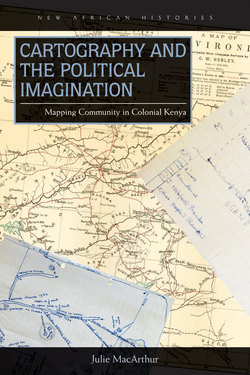Cartography and the Political Imagination

Реклама. ООО «ЛитРес», ИНН: 7719571260.
Оглавление
Julie MacArthur. Cartography and the Political Imagination
Отрывок из книги
Praise for Cartography and the Political Imagination
“The Luyia defy assumptions about African ethnicity. With neither myth of common descent nor shared vernacular speech, this modern community is yet no colonial invention. These least ‘tribal’ of Kenya’s peoples mapped their own territory of civic pluralism. In this new departure in ethnic studies, Julie MacArthur persuasively subverts our conventional wisdom.”
.....
Taking inspiration from Benedict Anderson’s seminal text Imagined Communities, two pioneering studies in this young field, Thongchai Winichakul’s Siam Mapped and Christopher Gray’s Colonial Rule and Crisis in Equatorial Africa, both emphasized the instrumental role of imperial mapmaking in the formation of new ethnic and national communities.85 Both studies began by sketching the cognitive mapping of space that existed before the intervention of colonial geography.86 Winichakul explored the sacred topographies of Buddhist thought alongside the ancient maps of Southeast Asia to demonstrate the “coexistence of different concepts of space.”87 Gray, on the other hand, built on Jan Vansina’s theory of “cognitive landscapes” that spatialize ideology on an intimate scale.88 For Gray, the cognitive mapping of kinship and clan hierarchies among the stateless communities of South Gabon allowed for the development of a socially defined form of territoriality.89 For both Winichakul and Gray, the introduction of colonial mapmaking constrained local practices of space, imposed imperial understandings of geography, and encoded boundaries as the delimiters of new ethnic and national bodies.
Historians of colonial territoriality have investigated the use of mapping in the spatial organization of gender relations, the micropractices of power and governmentality, and the relations and identities formed on frontiers and across borderlands.90 Postcolonial studies have further looked at colonial boundaries variously as artificial barriers, as delimiters of citizenship, and as conduits of exchange and interaction.91 But the underlying argument remains virtually the same: the introduction of modern mapping technologies marked a radical break that displaced older forms of geographic knowledge and prompted new formulations of community and identity. By focusing too narrowly on imperial and “official” maps, these studies risk eliding the “cartographic anxiety” that such processes produced and occluding the ways Africans, or indeed subalterns across the colonized world, informed, contested, and appropriated these colonial impositions.92
.....